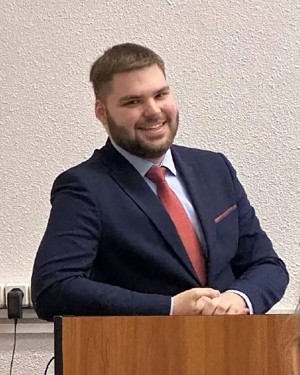Saving Private Customs Officer: RUDN young scientists develop a project of radiation dosimeter token
Every year, RUDN University hosts a competition of student scientific works “Common Start: Let’s Do Science Together.” The university provides scholarships for projects of young scientists and student associations. All developments are practice-oriented and have the potential for further commercialization.
One of the 9 winners this year is a development by young scientists from the Institute of Foreign Economic Security and Customs Affairs. The students are working on the project of a dosimeter token that will be able to protect customs officers from radiation exposure during cargo inspection and testing.
The research group included:
- Mikhail Filatov (“Customs affairs”, V course);
- Alexandra Sloneva (“Customs affairs ”, V course).
What is the relevance of your project?
“Now customs officers are using stationary systems for detecting fissile and radioactive materials. But now illegal movement of goods is not labeled as dangerous, people are at risk of radiation contamination without even suspecting it. In 2022, 213 attempts were recorded to illegally move fissile and radioactive materials. This is a minimum of 213 threats to the life and health of customs officials,” said Mikhail Filatov.
“A personal device that report on the state of radiation safety around a person is our idea how to solve this problem. Compared to a standard dosimeter of weight of 200 gm., our token will weigh 40 gm. The size of the device will be 6 centimeters long and 4 centimeters wide. If the radiation level next to a person is higher than normal, the device, thanks to the built—in open-circuit electrical circuit detecting radiation, will emit an appropriate signal,” said Alexandra Sloneva.
Are there analogues of the dosimeter token in other countries? Do customs officers have them?
“There is no complete analogue. The most similar device is a palm-sized wireless dosimeter. It can be used to detect and measure the level of ionization radiation. But in comparison with it, our token has several advantages:
- relatively low cost — on average, the cost of a portable dosimeter is 8000 rubles, our development, according to preliminary estimates, will cost 8 times less;
- mobility — your hands will be free due to its fastening on clothes;
- it functions in any weather.”
Who else will be able to use the radiation dosimeter token?
“The range of potential customers is not limited exclusively to customs officers. Laboratory staff or employees of nuclear power plants also encounter sources of ionization radiation. In the event of an accident at the facility or a failure of the radiation protection system, a person does not have a personal device that will report the danger. They, like customs officers, cannot rely solely on stationary radiation protection systems. And portable and stationary portable devices do not give an employee the opportunity to work with free hands,” Alexandra Sloneva.
The scientific director of the project is Zhanna Chupina, PhD in Economics, Deputy Director for Scientific Work at the Institute of Foreign Economic Activity and Customs Affairs, Associate Professor at the RUDN University.
The co-head of the project is Alexander Chupin, PhD in Economics, Deputy Dean for Research at the Faculty of Economics of the Russian Academy of Sciences.
Interviewed by Elena Balan


RUDN University summed up the results of the competition among scientific student societies and scientific circles. The GreenLab of the Institute of Ecology became the best Student Research Society, the second place was taken by the Institute of Foreign Languages, and the third place - the Faculty of Humanities and Social Sciences.
There are approximately 1,600,000 children in Russia with confirmed attention deficit hyperactivity disorder. The necessary therapy is not always available to their families due to cost or the lack of specialized centers nearby. Teachers and students at RUDN University and Altai State University have developed a special app for these children that increases attention and reduces anxiety using the color photostimulation method.
Student science and popularization tour club has been operating at the Institute of Environmental Engineering for five years now. It was established under the auspices of the GreenLab Student Scientific Society.
RUDN University summed up the results of the competition among scientific student societies and scientific circles. The GreenLab of the Institute of Ecology became the best Student Research Society, the second place was taken by the Institute of Foreign Languages, and the third place - the Faculty of Humanities and Social Sciences.
There are approximately 1,600,000 children in Russia with confirmed attention deficit hyperactivity disorder. The necessary therapy is not always available to their families due to cost or the lack of specialized centers nearby. Teachers and students at RUDN University and Altai State University have developed a special app for these children that increases attention and reduces anxiety using the color photostimulation method.
Student science and popularization tour club has been operating at the Institute of Environmental Engineering for five years now. It was established under the auspices of the GreenLab Student Scientific Society.